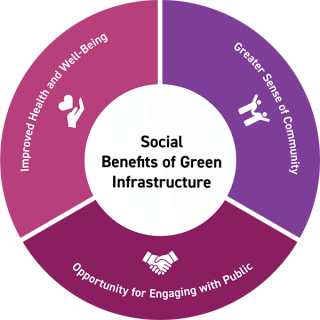Social Benefits of Green Infrastructure

Improved Health and Well-Being. The urban tree canopies, parks, green streets, and green spaces created by green infrastructure can provide a peaceful atmosphere for residents to enjoy. More green space and parks promote outdoor physical activity and can be used to improve safety. Green spaces have been shown to enhance the strength of social ties between neighbors, which can lower rates of social disorder, anxiety, and depression within a neighborhood.1 Experiencing green spaces helps reduce mental fatigue or stress.2 In densely developed areas, adding green infrastructure provides vegetation and open space in locations that can be nature deprived. Additionally, green infrastructure with vegetation can further benefit residents by improving air quality and reducing noise pollution.
EPA resources:
- Healthy Benefits of Green Infrastructure in Communities (pdf)
- Southwest Rockford Revitalization Rapid Health Impact Assessment
Other resources:
- Health Impact Assessment of Philadelphia’s 2025 Tree Canopy Cover Goals
- American Planning Association, Health and Green Infrastructure (pdf)
Greater Sense of Community. Green infrastructure, such as green streets and parks, can serve as a destination for residents or visitors to enjoy a peaceful place to appreciate nature or connect with others in the community. Greening efforts that bring all community members in the planning process can create a greater sense of place that is welcoming, safe, and meaningful within their neighborhood. For example, a small pocket park with green infrastructure could be used to create a new community green space while addressing concerns about a vacant lot.
EPA resources:

Opportunity to Engage with the Public. Green infrastructure investments, like all significant infrastructure investments, provide an opportunity to engage residents in building a vision for their community. For example, community participation in green infrastructure planning could reveal community concerns about road safety, which could lead to new plans for pedestrian bump outs on street corners that simultaneously improve road safety and treat stormwater through bioretention. Engaging community members in planning, implementation, and maintenance of green infrastructure can provide an opportunity for enhanced community cohesion, leading to the development of more accessible and community-oriented spaces.
EPA resources:
1 U.S. EPA. Southwest Rockford revitalization rapid health impact assessment: Rockford, Illinois. EPA/600/R-22/081.
2 Barton J, Rogerson M (2017). The importance of greenspace for mental health. BJPsych International 14(4): 79–81.
